The Museo Nacional del Prado in Madrid is a veritable temple of European art, housing masterpieces from titans like Goya, El Greco, Bosch, Titian, and Rubens. Yet, amidst this constellation of artistic brilliance, one work shines with unparalleled luminosity: Diego Velázquez’s Las Meninas.
Painted in 1656, this enigmatic canvas transcends the realm of mere portraiture, becoming a profound meditation on the nature of reality, illusion, and the very act of seeing. In this exploration, we will delve into the captivating intricacies of Las Meninas and why it alone justifies a pilgrimage to Madrid.
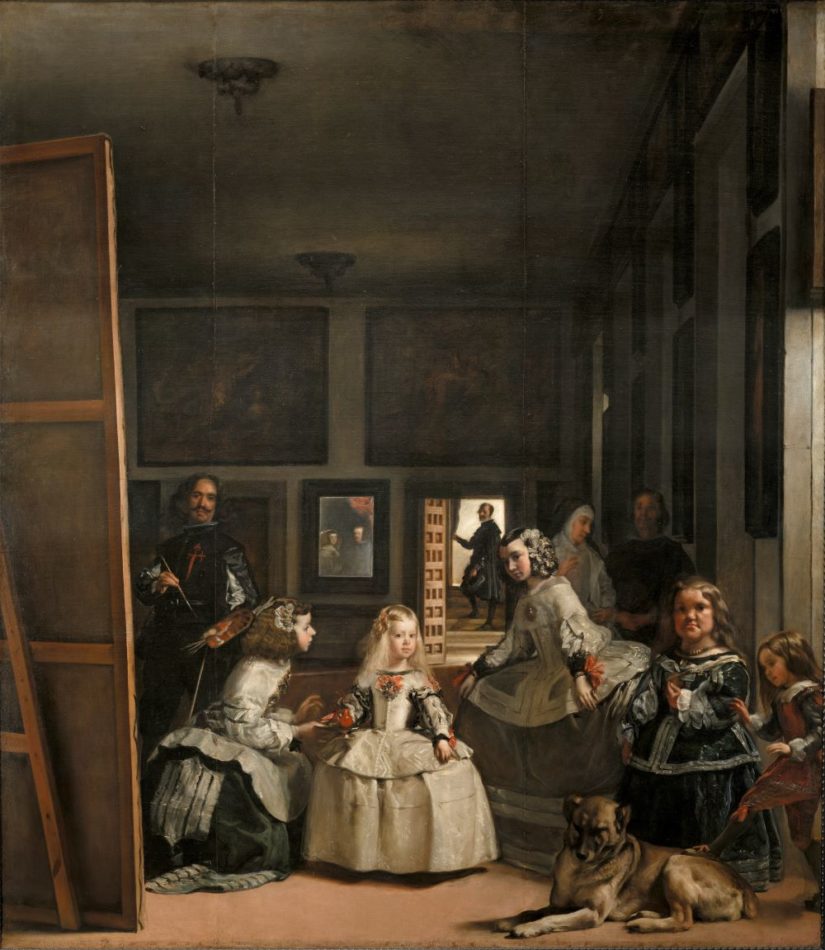
1. Diego Velázquez: Las Meninas (1656–57) oil on canvas, Museo del Prado, Madrid. Public domain image, retrieved from Wikimedia Commons.
Velázquez: The Virtuoso Behind Las Meninas
Before we embark on our journey into the heart of Velázquez’s Las Meninas, it’s essential to understand the artistic genius who brought it to life.
Diego Velázquez (1599-1660), a luminary of the Spanish Golden Age, was the preeminent artist in the court of King Philip IV of Spain. His exceptional talent manifested in his meticulous rendering of detail and masterful brushwork, evident in his numerous portraits of the royal family, historical scenes, and genre paintings.
Velázquez’s artistic evolution was profoundly influenced by the Italian Baroque, particularly the dramatic lighting technique known as tenebrism. He employed tenebrism to create a sense of drama and intensity through stark contrasts of light and dark, a hallmark of Velázquez’s Las Meninas.
Velázquez’s Las Meninas: Brushstrokes of Revolutionary Influence
But Velázquez was far more than a technically gifted artist; he was a true innovator. He boldly transcended the rigid formality of traditional courtly portraiture. Instead, he infused his subjects with a naturalism and psychological depth that foreshadowed the realism of later centuries. His works, including the iconic Velázquez’s Las Meninas, served as an inspiration for generations of artists, notably the Realists and Impressionists of the 19th century.
Consider Édouard Manet, the 19th-century French art revolutionary who fell head over heels for Velázquez’s work. Drawn to Velázquez’s dazzling light, bold strokes, and daring compositions, Manet traveled to Madrid to experience these masterpieces firsthand.
Later on, Manet, like Velázquez in Las Meninas, challenged traditional notions of perspective and spatial representation. He embraced Velázquez’s expressive brushwork and audacious use of color, forging a path toward Impressionism. Clearly smitten with Velázquez, Manet even declared him “the painter of painters” and “the greatest painter that ever was.”
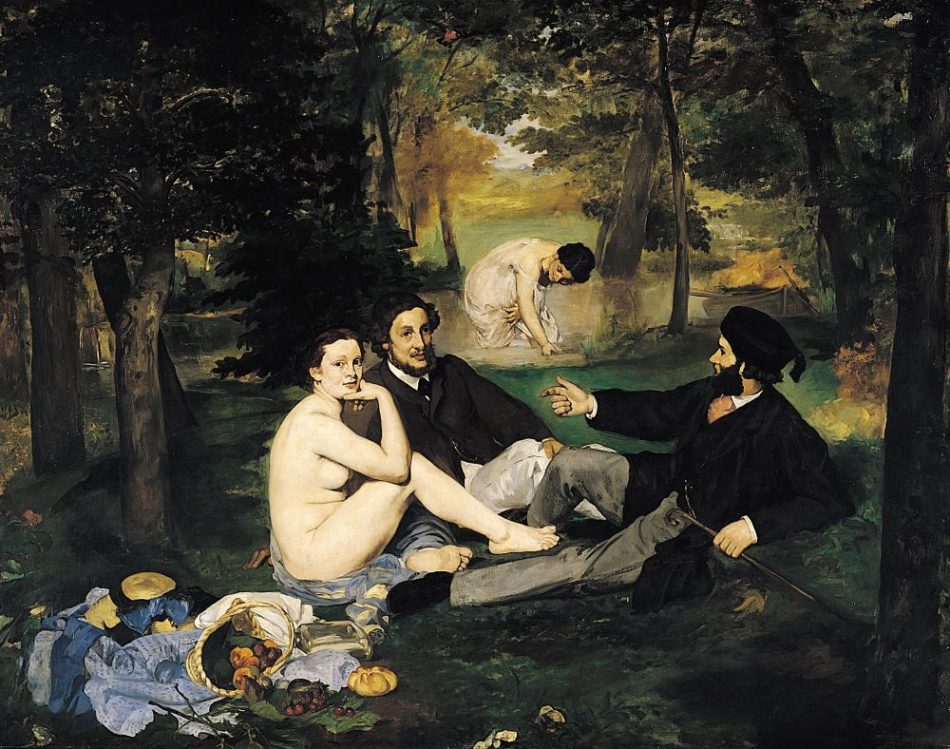
Édouard Manet : Le Déjeuner sur l’herbe (1863), oil on canvas, Musée d’Orsay, Paris. Public domain image, retrieved from Wikimedia Commons
Velázquez’s Las Meninas: A Symphony of Light and Composition
Las Meninas, meaning “The Maids of Honor”, transports us to Velázquez’s studio in the Royal Alcázar of Madrid. This imposing canvas, measuring 318 cm × 276 cm. / 10.4 ft × 9 ft., presents a complex tableau vivant.
At the heart of this scene stands the five-year-old Infanta Margaret Theresa, daughter of King Philip IV and heir to the Spanish throne. Surrounding her are her maids of honor (the meninas), a chaperone, a bodyguard, two dwarfs, and a dog. Velázquez himself is prominently featured, standing at a large canvas, seemingly engrossed in the act of painting.
Light as a Protagonist of Velázquez’s Las Meninas
However, the true protagonist of Velázquez’s Las Meninas is arguably the light itself. Velázquez masterfully orchestrates a luminous interplay of light and shadow, creating a three-dimensional space that draws the viewer into the scene.
Light streams in from multiple sources, illuminating the figures with varying intensities and casting subtle shadows that add depth and complexity to the composition. The Infanta, bathed in a soft, radiant light, becomes the focal point, while the surrounding figures recede into varying degrees of luminosity.
This masterful use of light not only creates a sense of realism, but also imbues the painting with a symbolic dimension, with the Infanta, bathed in light, potentially representing innocence and hope amidst the shadowy complexities of the court.

Image of Infanta Margarita (fragment), cropped from Diego Velázquez’s Las Meninas (1656–57) oil on canvas, Museo del Prado, Madrid.
Brushstrokes and Dynamism
Further enhancing the painting’s visual dynamism is Velázquez’s innovative use of loose brushstrokes. When viewed up close, the figures appear to dissolve into an abstract dance of color and texture.
Yet, as the viewer steps back, these individual marks coalesce into a remarkably detailed and lifelike scene. This technique, a precursor to Impressionism, adds a sense of immediacy and movement to the painting, inviting the viewer to engage with it on multiple levels.
Composition and Perspective
Moreover, the composition of Velázquez’s Las Meninas is nothing short of revolutionary. The seemingly casual arrangement of figures belies a carefully constructed design that plays with perspective and spatial relationships.
The inclusion of the mirror, reflecting the King and Queen, adds another layer of complexity, blurring the lines between the real and the reflected, the present and the absent. This ambiguity challenges the viewer’s perception and invites contemplation on the nature of reality and representation.
Velázquez’s Las Meninas Political Significance
Furthermore, it is important to note that this painting was not merely an artistic exercise; it was also a statement of political significance. As the Infanta was the heir to the throne, Velázquez’s Las Meninas served as a subtle yet powerful affirmation of her position and a testament to the continuity of the Habsburg dynasty in Spain.
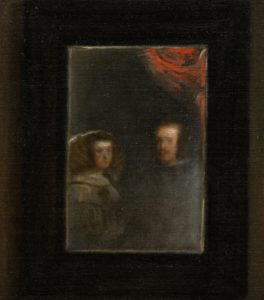
Image of the mirror detail (fragment), cropped from Diego Velázquez: Las Meninas (1656), oil on canvas, Museo del Prado, Madrid.
Velázquez’s Las Meninas: A Mirror to Reality and Illusion
Therefore, Velázquez’s Las Meninas is not merely a group portrait; it is an exploration of the very nature of perception and representation. Velázquez masterfully employs perspective, geometry, and visual illusion to create a tangible space that simultaneously challenges our understanding of reality.
This interplay of reality and illusion resonates with the topic of “ut pictura poesis” – “as is painting, so is poetry” – a notion that gained prominence during the Renaissance and Baroque periods. Artists of this era, including Velázquez, sought to elevate painting to the status of a liberal art, on par with poetry, by demonstrating its capacity for intellectual and philosophical exploration.
Las Meninas, with its complex composition and ambiguous narrative, exemplifies this endeavor, inviting viewers to contemplate the relationship between art and reality, the creator and the observer.
Beyond the Canvas: The Secrets of Velázquez’s Las Meninas
However, there’s a curious contradiction within the painting itself. Despite his immense talent and prestigious position as a court painter, Velázquez couldn’t join the Order of Santiago. This was due to the Order’s strict rules about nobility, which his family history, unfortunately, didn’t meet.
Yet, the cross of Santiago is clearly visible on his tunic in the painting. It was most likely added later by King Philip IV himself, perhaps as a tribute or a symbolic gesture acknowledging Velázquez’s artistic contributions and his yearning for noble status.
Furthermore, Velázquez’s Las Meninas also provides a captivating glimpse into the social dynamics of the Spanish court. The painting beautifully captures the complex relationships between the royal family, their entourage, and the artist himself. It’s a fascinating window into a world of power, privilege, and artistic ambition.
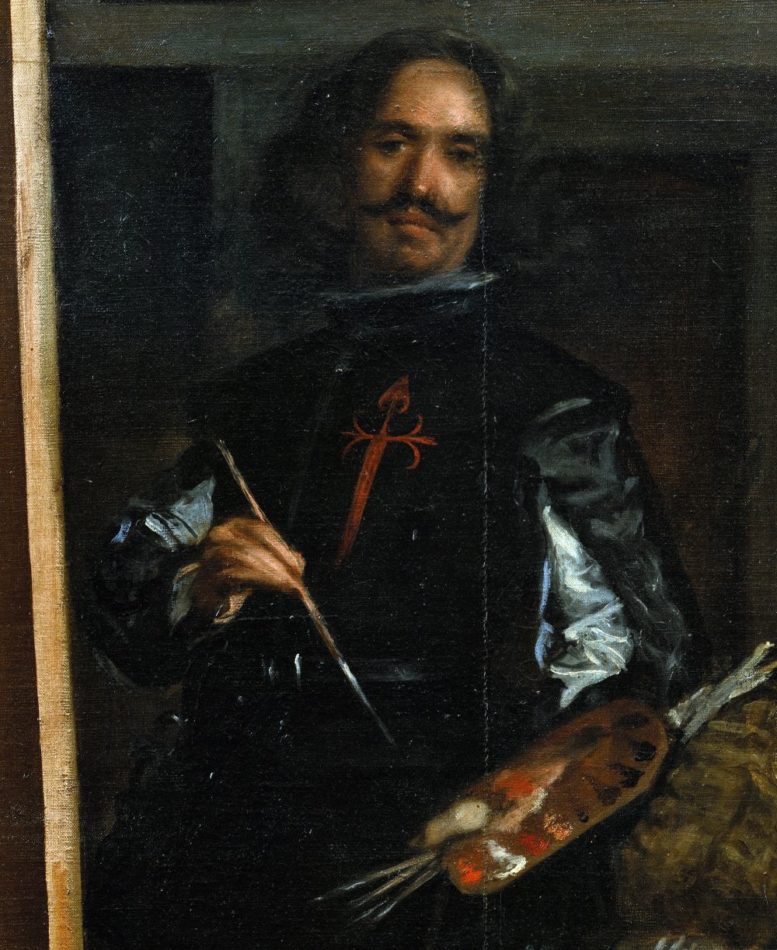
Velázquez’s self-portrait (fragment), cropped from Diego Velázquez: Las Meninas (1656–57), oil on canvas, Museo del Prado, Madrid.
Velázquez’s Las Meninas: A Legacy of Influence
The enduring fascination with Velázquez’s Las Meninas lies in its ability to engage viewers in an ongoing dialogue. Its complex composition, masterful use of light, and enigmatic narrative have inspired countless interpretations and analyses over the centuries. Artists throughout history, deeply captivated by Las Meninas, have created their own variations on the theme, further solidifying its place in art history.
One of the most notable examples is Pablo Picasso, who, in 1957, produced a series of 58 paintings based on Velázquez’s Las Meninas. These works, ranging from Cubist interpretations to more abstract variations, demonstrate Picasso’s profound engagement with Velázquez’s masterpiece and its enduring relevance for modern art.
But Picasso was not alone in his admiration for Velázquez. Artists such as Salvador Dalí, Francis Bacon, and even contemporary photographers like Thomas Struth have engaged with Las Meninas in their own unique ways, demonstrating the painting’s enduring power to inspire and challenge artistic conventions.
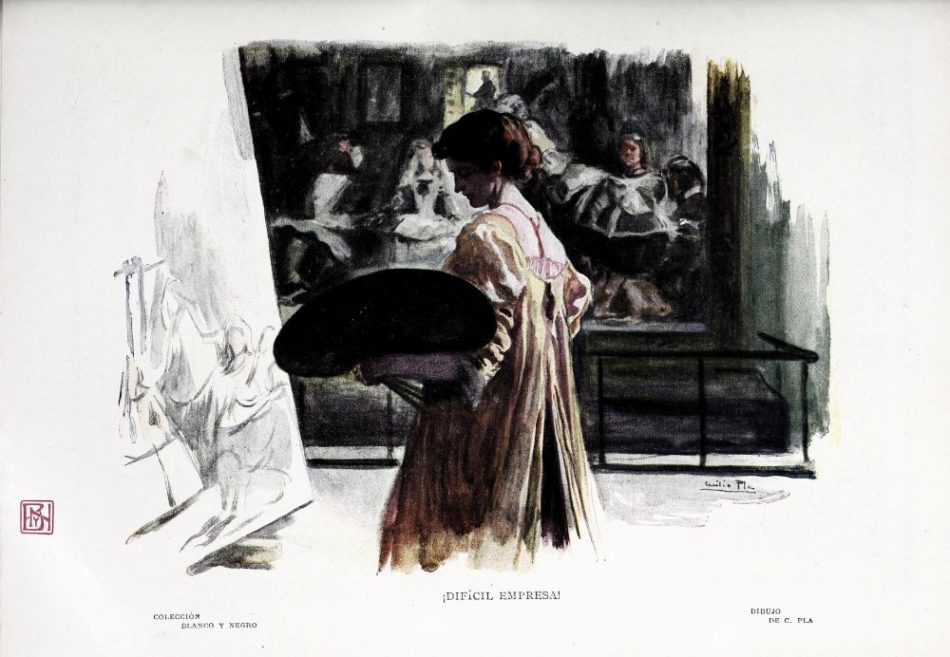
Cecilio Pla: ¡Difícil empresa! (Published in Blanco y Negro, March 9, 1907). Public domain image, retrieved from Wikimedia Commons.
Beyond Las Meninas: El Prado’s Greatest Hits (and Where to Find More!)
While Velázquez’s Las Meninas undoubtedly reigns supreme, the Prado Museum is a treasure trove of masterpieces from Spanish and European art history. Think of it as a delectable tapas spread of artistic delights, with something to satisfy every palate. From the dramatic compositions of Goya to the ethereal figures of El Greco, the Prado’s collection will leave you craving more.
El Prado’s Greatest Hits: A Feast for the Senses
First, let’s talk about those must-see masterpieces. You’ll find works by Goya, El Greco, Bosch, Titian, Rubens – you name it, they’ve got it. Here are a few highlights to whet your appetite:
- Goya’s The Third of May 1808: This poignant depiction of the Spanish resistance against Napoleon’s forces captures the brutality of war with unflinching realism. Goya’s masterful use of light and shadow amplifies the emotional intensity of the scene, leaving a lasting impression on the viewer.
- Bosch’s The Garden of Earthly Delights: Prepare to be transported to a surreal and fantastical world in this bizarre triptych. Bosch’s intricate details and allegorical symbolism will keep you captivated for hours as you try to decipher the hidden meanings within this enigmatic masterpiece.
- El Greco’s The Nobleman with his Hand on his Chest: This penetrating portrait exemplifies El Greco’s distinctive style, characterized by elongated figures and a mystical atmosphere. The subject’s intense gaze and elongated hand draw the viewer into a world of introspection and spiritual contemplation.
A Curated Journey Through the Prado Museum in Madrid
But wait, there’s more! If you’re eager to delve deeper into the Prado’s artistic riches, I’ve got just the thing for you. Check out this curated article about the Prado’s highlights: Top 16 El Prado Museum Most Famous Paintings [Selected by Art Historian]. It’s packed with juicy details and insider tips to help you navigate this artistic wonderland. Consider it your personal guide to the Prado’s greatest hits!
Planning Your El Prado Pilgrimage to See Velázquez’s Las Meninas
Ready to embark on your artistic pilgrimage to witness Velázquez’s Las Meninas in person? Here are a few practical tips to ensure a smooth and enriching visit:
- Time Your Visit: Late afternoons often offer a respite from the crowds, allowing for a more contemplative experience. Imagine having Velázquez’s Las Meninas practically to yourself!
- Allocate Sufficient Time: The Prado’s vast collection warrants at least three hours to appreciate its highlights. However, true art aficionados may find themselves lingering for an entire day!
- Secure Your Entry: Skip the queue by purchasing your entry online. This will save you precious time that you can dedicate to admiring the masterpieces.
- Navigate with Ease: The closest subway station is Banco de España. However, from Atocha station, you can also reach the museum easily.
Conclusion: A Masterpiece Awaits in Madrid
Velázquez’s Las Meninas is more than just a painting; it is an encounter, a conversation, a journey into the depths of artistic genius. Its complex composition, masterful use of light, and enigmatic narrative continue to captivate and challenge viewers centuries after its creation.
A visit to the Prado Museum to experience Las Meninas firsthand is an essential pilgrimage for any art enthusiast, offering a glimpse into the heart of Spanish art and the enduring power of a true masterpiece.





Leave a Reply